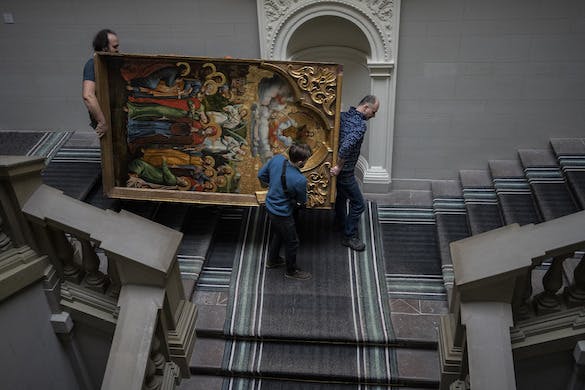Lviv, City on the Edge
Most evidence of Soviet rule has been erased, though large murals depicting workers on buildings outside the Old Town preserve some of Socialist realism’s cultural notes.

LVIV, Ukraine — While Russia’s invasion of Ukraine has thrown the country into an existential struggle for survival, parts of Lviv, Ukraine’s largest western city, move at much the same meandering pace they did before the war arrived.
On Svobody Prospekt — Ukrainian for Liberty Avenue — elderly women trudge on with their list of afternoon errands with grandchildren in tow. However, the younger and more able-bodied are already preparing for the arrival of an unfolding conflict that threatens to upend any semblance of normality here.
On Nicolaus Copernicus street, workers at a high-end confectionery drill plywood sheets into window frames and board up the building, protecting the shop’s Art Nouveau interior.
Lviv has attracted different ethnic groups and traded hands repeatedly over the centuries, imbuing the city with a cosmopolitan flavor reflected in its Austro-Hungarian buildings, preserved Polish signage, and repeated attempts at Germanization.
Most evidence of Soviet rule has been erased, though large murals depicting workers on buildings outside the Old Town preserve some of Socialist realism’s cultural notes.
City employees gave Lviv’s Latin Cathedral, a 14th century Roman Catholic structure in the city’s Old Town, a wartime makeover this week, covering the stained-glass chancel windows with sheets of steel and foam.
Workers also wrapped statues and monuments throughout the city in thick sheets of textile and plastic and erected scaffolding around them. They are receiving the same treatment as the place of worship.
Outside the city, landscape that would exude a serene agricultural flavor during peacetime takes a decidedly more martial bent.
Freshly tilled fields stretch away from Lviv. The rich soil is jet-black, like vast pools of ink.
Ukraine was the breadbasket of the Soviet Union and is one of the world’s top wheat- and grain-exporting countries today.
“So much grows in Ukraine,” Alla Ivanova, a 33-year-old Ukrainian mother of one, explained. Despite the country’s agricultural productivity, “Ukraine is still so poor.”
Small, single-lane roads fan out from the main east-west highway leading to Lviv toward small farming villages and hamlets. Locals brace for the Russian onslaught by arranging sandbags, old car tires, and concrete blocks over their roads, transforming them into ersatz fighting positions.
Czech hedgehogs — anti-tank obstacles made of three steel beams or railroad ties welded together at their axes — ring gas stations. Concertina wire and homemade spike strips protect checkpoints just outside the city.
Military aid from Europe flows eastward to Lviv, and many of Ukraine’s more than two million refugees have transited the country on their way to the west.
Soviet-era jalopies in pastel colors, brand-new black German SUVs, and multi-hued electric cars are packed with people and belongings, choking the roads in and out of town.
Once within the city limits, familiar urban rhythms co-exist alongside wartime exigencies.
The war has not touched Lviv like it has some eastern cities — at least, not yet — but government buildings are guarded by armed police and military personnel are stationed at entrances, peering out from thickly sandbagged positions.
Photographing military personnel, equipment, vehicles, and installations is strictly forbidden.So are sales of alcohol in both supermarkets and restaurants. Grocery stores throughout the city have curtailed their hours to comply with a nighttime curfew.
The city’s pre-war population of just more than 720,000 has ballooned rapidly since the Russian invasion late last month. Hundreds of thousands of people have made their way through the city in the past two weeks, making precise population estimates impossible.
A measure of the influx is the scarcity of hotel rooms; many properties are already operating at more than 100 percent capacity.
Ukraine has prohibited all adult men between the ages of 18 and 60 from leaving the country in anticipation of a draft, but some do manage to leave under the guise of humanitarianism.
Ukraine’s orphan population, exacerbated by the conflict, has swollen to about 200,000, and not all of them are registered in state orphanages or with foster parents, explained Aerial Recovery Group, an NGO that is helping vulnerable people leave Ukraine.
Legal guardians can exit the country with their young charges, irrespective of gender, and provide a ticket out for some men desperate to escape. Once across the border, however, “not all the kids end up in foster care or orphanages.”
Unlike Ukraine’s eastern regions, where Russian is spoken in tandem or more often than Ukrainian, Lviv is a bastion of Ukrainian culture and language.
Small acts of protest pop up in graffiti, posters, and pamphlets throughout the city. One bicycle messenger decorated his delivery bag with a phrase in Ukrainian that politely translated calls Vladimir Putin a maggot.
Today marks 161 years since the death of Taras Shevchenko, the prolific Ukrainian poet and artist whose works became the germ of the Ukrainian national idea. A larger-than-life statue of Shevchenko near the city center is framed by a 40-foot stele adorned with scenes from Ukrainian folklore and decked with yellow and blue bunting, the Ukrainian national colors.
Although Shevchenko was born into a family of serf peasants, he died at age 47 a free man.
Earlier this week, long lines of people clutching luggage and children snaked outward from Lviv’s central train station, waiting their turn to board a westbound train.
An air raid siren briefly wailed, warning of some incoming danger. Was it a false alarm, a system test, an accident? Impossible to know. For the hundreds of people waiting at the station, though, it was evidently one of their first encounters with the war. While the alarm blared for just 15 or 20 seconds, some sections of the lines of people disappeared almost instantly.
Those from Ukraine’s east and accustomed to sirens fled the open square in front of the train station. Those from areas yet unscathed remained in line, blinking quizzically at their rushing compatriots.
The city’s resources are so strained and stretched thin from the influx of people — or so this reporter heard — that trains from the east won’t stop in Lviv.
Instead, they will press on directly to Poland. Other trains still make their usual stops at the city’s central station and exchange thousands of passengers according to timetables modified by war.
A recent Time magazine cover can be seen around Lviv, placed with evident pride. Atop the familiar yellow and blue is text written in Ukrainian: “Life will conquer death,” it reads, “and light will conquer darkness.”

